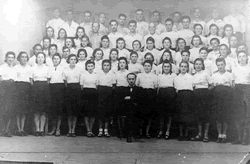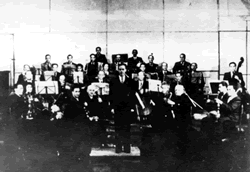Music in the Vilna Ghetto ( from the Yad Vashem site)
Vilna, Poland. The ghetto choir and the conductor Wolf Durmashkin, who perished in the Klooga Slave Labor Camp
Vilna, Poland. An orchestra
The songs presented here are an assortment from theatrical and cultural productions organized in the Vilna ghetto. The songs were written by young composers; some of the melodies were created by those residing in the ghetto, and some were taken from the popular prewar musical repertoire, composed by many local artists (not necessarily Jews). The poet, author, educator, collector and partisan Shmerke Kaczerginski wrote the lyrics for three songs (nos. 6, 7 and 10) and performed them himself. Songs no. 6 and 7 were also performed by the singer Betty Segal, accompanied by an accordion. The songs tell of the tragedy of the Jewish community in Vilna, but they also express the hope that it would soon witness liberty once more.
Shtiler, Shtiler – Quiet, Quiet ( go to the Yad Vashem site to hear the music)
Friling – Spring
Shotns – Shadows
Tsi Darf es Azoy Zayn? – Does It Have to be This Way?
Dos Elnte Kind – The Lonely Child
Songs in the Vilna Ghetto
The history of the Jewish community in Vilna during the Holocaust began on 19 September 1939, when the Red Army entered the city. The Lithuanians were given control of Vilna, but in June 1940 it came under Soviet rule once more, when Lithuania was annexed by the Soviet Union. These changes only increased the antisemitic acts carried out by the Lithuanians.
In June 1941, the Germans invaded the Soviet Union, and Vilna was subjugated by the Nazis. The Lithuanians continued to perpetrate antisemitic activities, and as the Germans began to commit mass murder, the Lithuanians were only too ready to assist. The German administration forced the Jews to don an armband bearing a Star of David, forbade them from using public transportation and entering public areas in the city, imposed curfews, rationed food, confiscated their telephones and seized their properties.
The mass murder of the Jews of Vilna began with the arrival of the Einsatzkommando 9 unit in the town in late June 1941. The murders were carried out in Ponary, a scenic forest and popular holiday resort south of Vilna, easily accessible by train. Some 5,000 Jews were massacred at Ponary between 4 and 20 July 1941. On 31 August, more Jews were murdered at Ponary, prior to the establishment of the ghetto.
On 6 September 1941, the Nazis established two ghettos, to which the Jewish residents of Vilna were exiled. The residents of the ghettos were soon divided up into categories: the “productive” population – craftsmen and workers with permits – gathered in Ghetto No. 1; the remainder in Ghetto No.2. Two Jewish councils – Judenrat – were established. Ghetto No. 2 was liquidated on 21 October 1941. At the beginning of 1942, the head of the Jewish Police in Ghetto No. 1, Jacob Gens, became the head of the Judenrat.
The Nazis continued to reduce the number of Jewish residents in Ghetto No. 1 by issuing work permits (yellow cards) that promised continued habitation in the ghetto. The others were sent out of the ghetto. From a population of 28,000 Jews, only 12,000 remained, and 8,000 went into hiding. The Vilna ghetto was liquidated in September 1943. When the Gestapo discovered that Gens had had contacts with the partisans, they called him in for questioning. Gens reported to the Gestapo headquarters and never returned. One of the Gestapo officers told the Jewish Police that Gens had been shot for his actions. A few days later, the ghetto was liquidated. Those partisans that had not yet fled escaped to the forests, where they continued their campaign of resistance.
Culture in the Vilna Ghetto
Before the war, Vilna boasted such a rich Jewish culture that is was known as “the Jerusalem of Lithuania.” Despite the reduction of its population to one third of its prewar level, the community in the ghetto managed to rehabilitate itself through the creation of a flourishing cultural life. First priority was given to the children and their education. Two or three schools were established and later a cheder and two yeshivot were founded by the Orthodox community. An working library was opened, which also housed the archives and museum of the Jewish community.
Music institutions were also set up in the ghetto. Under the direction of Abraham Slep and Tamara Girshovitsh, a music school teaching piano, violin, singing and music theory was founded. The famous conductor Yaakov Gershteyn revived his student choir. In December 1941, a small orchestra was formed conducted by Wolf Durmashkin, a talented conductor from Warsaw. The orchestra performed 35 concerts of symphonies from the classical repertoire, including works by “Aryan” composers.
Cultural activities centered on a Zionist ideology also took place in the ghetto, under the auspices of the “Brit Ivrit” (Hebrew Union). A Hebrew choir was established, and another, smaller choir performed pioneering songs, biblical texts, Chassidic melodies and more. Brit Ivrit also ran a Hebrew theater. Conducted by Abraham Slep, a Yiddish choir performed Yiddish songs – mostly folk tunes – accompanied by the orchestra, and another choir sang liturgical music.
The founding of the ghetto’s theater was controversial. In May, a young man called Viskind convinced the authorities that the theater would play an important role in raising the spirit of the ghetto residents. The theater put on four performances from the dramatic Yiddish repertoire. After the theater was established, a writers and artists union was set up, headed by Zelig Kalmanovitch, to encourage creative enterprises in the ghetto and promote art and culture. The ghetto musicians set up their own association in February 1942, with a membership of fifty. These organizations promoted art competitions, cultural events and provided assistance for struggling artists. (The song “Shtiler Shtiler” [Quiet, Quiet] was written in this vein.)
The Jewish community of Vilna, which had been slashed to one third of its original size and which had endured the traumas of mass murder by the Germans and Lithuanians, thus turned to its richest and most dependable wellspring – culture – to build a Jewish life of meaning and hope.
The songs from the Vilna ghetto describe life and events within its walls: the massacre at Ponary, work permits, despair, hope and longing. The songs bear witness to the tragedy and devastation in the ghetto, while connecting these events to the history of the Jewish people and its source of faith by drawing on biblical stories and historical figures as a source of comfort and hope that despite its hardships, the Jewish people would prevail.
The theatrical and cultural performances were organized by the Jewish Police, headed by Jacob Gens. The audience was peppered with Jewish police officers and members of the Judenrat, as well as a number of Nazis. The presence of the latter so angered one of the Jewish intellectuals in the ghetto, Herman Kruk, that he protested against the theater’s shows. However, once the theater became an important meeting place, the protests ceased. Though the theater was censored by the Judenrat and the Jewish Police, they continued to encourage its activities as a calming and stabilizing factor in their policy of “Work for Life.”
Like Chaim Rumkowski, Jacob Gens used the theater stage to deliver his speeches and present his policies. He believed that the theater would bring comfort to the residents, reducing their suffering by allowing them to “escape” to a different world.
Most of the songs of the Vilna ghetto freely express the nature of ghetto life. Some of the songs describe life in the ghetto with humor and satire, in order to deflect the heaviness of the suffering and bring a smile to the faces in the audience, thus helping them cope with the situation. The majority was written by professional poets and composers specifically for the theater or other organized cultural frameworks. Many of them were collected and published by Shmerke Kaczerginski, who lived in the Vilna ghetto and edited recordings for the Central Jewish Historical Commission in Munich in 1946. In 1948 Kaczerginski also assembled, edited and published an anthology of songs, Lider fun di Getos un Lagern (Songs from the Ghettos and Camps) – most of them from the Vilna ghetto.
Many of the songs of the Vilna ghetto are still performed today at Holocaust remembrance ceremonies in Israel and abroad. These compositions continue to resonate among the public due to their quality and valuable messages of hope, struggle and the national survival of the Jewish people.

